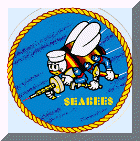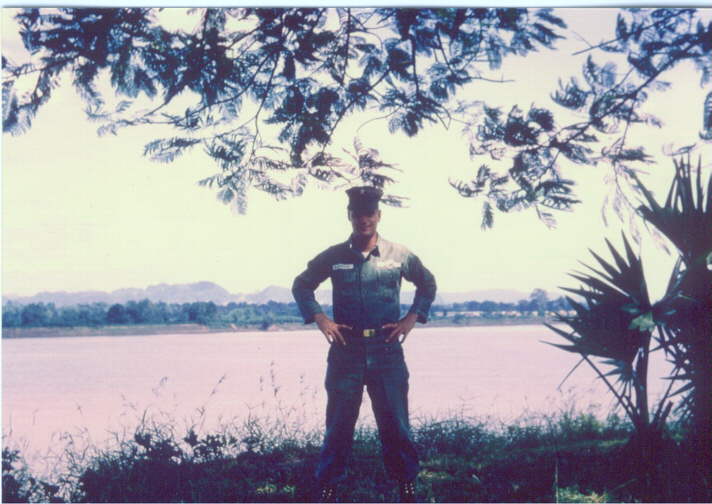|
In August of 1962, U. S. Naval
Mobile Construction Battalion Three (MCB 3) deployed to Camp Kinser in Okinawa to serve as the Alert Battalion in the Pacific.
Orders were received to re-deploy a major portion of the battalion to Nakhon Phanom (NKP), Thailand to construct a logistic
support airfield. These orders were delayed several weeks by the Cuban Missile Crisis but, within a few weeks of arriving
in Okinawa, Secretary of Defense McNamara personally approved the re-deployment.
The Battalion CO, Cdr. David P. Whyte,
OPS Officer Lt. Robert P. Phenix and Cdr. Ben Saravia of the Commander, Naval Construction Battalions Pacific (COMCBPAC) staff
in Pearl Harbor visited the construction site in early August. Initially, the airfield was to be constructed adjacent
to the West side of the town of Nakhon Phanom, but this site was subsequently moved ten miles farther west in order to place
the airfield out of mortar range from Tha Khek, Laos, just across the Mekong River. The airfield to be constructed was
designed to be 100 feet wide, 5000 feet long, would have 500 foot overruns on each end of the runway, a Parking Area, a Marshaling
Area and a Taxiway/Warm-up pad.
Upon receiving the re-deployment orders, an advanced party was formed and sent to NKP
with the mission of building a camp area where everyone could live, while constructing the airfield. This camp was located
on the West side of the town of Nakhon Phanom. Cdr. Whyte decided to deploy the main body of MCB 3 to NKP which would
consist of a portion of Headquarters Company, Alpha (heavy equipment) Company and Delta (construction) Company. This
amounted to approximately 325 personnel covering all necessary trades and skills. The remainder of the MCB 3 would remain
in Okinawa at Camp Kinser.
The necessary equipment was loaded on the USNS Muskingum for transport from the port of
Naha in Okinawa to Bangkok, Thailand. Several Seabees rode the ship with the equipment and upon arrival in Bangkok the
equipment was off loaded and everything that could travel by rail was sent by train to Udorn, Thailand were it was off loaded
and then driven to NKP. Most of the Seabees being sent to NKP flew from the US Air Force Kadena Air Base in Okinawa
on November 4, 1962 in KC-135s and landed in Udorn, Thailand the same day. Upon arriving in Udorn we were greeted by
several Buddhist Monks in saffron robes and several water buffalo next to the runway. At this time we split into three
groups. One group flew to Bangkok to drive the large equipment to NKP, one group flew into the small dirt landing strip
in NKP next to the base camp, and the other group stayed in Udorn to drive equipment, that had arrived by train, over the
road to NKP. It was 150 miles from Udorn to NKP and the road was unpaved, rutted and buffalo wallered. Throughout
the deployment, MCB 3 continued to haul equipment and supplies, such as Pierced Steel Planking (PSP), over this road.
Meanwhile,
approximately 55 personnel went to Bangkok to drive the large equipment (too large to be carried on the train to Udorn) to
NKP. Ltjg. Richard Y. Wisenbaker was the OIC of this convoy. The route from Bangkok to NKP was approximately 550 miles long
and included 150 miles of paved road from Bangkok to Korat. Unfortunately, the remaining 400 miles were unpaved, rutted,
buffalo wallered roads with bamboo bridges that could not support the weight of the heavy trucks and construction equipment.
All rivers had to be forded and it took 16 days for the convoy to cover the 550 miles. After 16 days on the road, the
convoy of heavy equipment arrived in NKP and it was time to get to work on the airfield.
First the site had to be cleared,
then all organic matter had to be grubbed out of the soil, then borrow pits had to be opened so we could get good fill dirt
that could be properly compacted, then we started bringing the airfield up to grade. To do this we worked two 10 hour
shifts (0600-1600 and 1600-0200) followed by a fuel and lube crew from 0200-0600, six days a week.
Shortly after arriving
at NKP and starting work, MCB 3 decided that it needed more prime movers and scrapers to move the laterite fill from borrow
pits to the runway site. We also decided that the 5 ton sheep foot rollers that we had were not heavy enough to properly
compact the laterite. Six additional prime movers, four more scrapers and two ten ton sheep foot rollers were ordered.
This equipment was shipped from the Seabee Center in Port Hueneme, California to Bangkok. Once again the equipment had
to be driven over the road 550 miles to NKP. Ltjg. George E. Fowler was the OIC of this convoy. During this convoy
from Bangkok to NKP there was a major accident caused by the extremely poor roads. Unfortunately, a Seabee was killed
when the steering apparatus on one of the prime movers failed, the tractor hit a tree, and the tractor turned over on him.
Upon
arriving back in NKP, the work went on at an accelerated pace. The goal was to have everything completed by the end
of June 1963. As the airfield came up to grade, the drainage ditches across the center of the runway were put in and
the conduits for future runway lighting were installed. Then after final grade was achieved, it was time to "shoot"
the airfield with emulsified asphalt and then cover it with PSP. Once the PSP was laid it was staked along the edges
to keep it from rolling up in front of landing aircraft. We were only approximately three weeks from finishing the entire
job when the monsoon rains started. They were several weeks early that year. Because of the rain, we could not
finish the airstrip at this time.
A decision was made that everyone would return to homeport in Port Hueneme, California
while the rains were coming down, except for a detachment of 35 Seabees who would remain in NKP. The detachment OIC
was Ltjg. George E. Fowler and the mission was to maintain drainage at the airfield site, maintain the construction equipment
and make sure that it would be ready to go back to work when the rains stopped, and to tear down a portion of the base camp
that would not be required in November when everyone returned to finish the work.

A second plane lands carrying dignitaries
for the NKP Opening Ceremony. (June 1963)
Even though the Warm-up pad, Taxiway, Parking Area, and Marshaling Areas
were not totally completed, an Opening Ceremony was held in mid-june 1963. An Air Force C-123 was the first plane to
land on the airfield and it was followed by planes carrying members of the US Embassy, the Commander of the US Military Advisory
Command, Thailand, and the Thai Prime Minister. The US Ambassador to Thailand, Ambassador Young was a speaker.
The runway was officially opened.
After the ceremony was complete, several C-130s landed and all but 35 Seabees boarded
the planes for the first leg of the trip back to the states. The Detachment that remained was known as Detachment Whiskey.
Finally, in November the rains stopped and Seabees returned to NKP to finish the airfield.
All work was completed and
the equipment that could be sent to Bangkok via the rail system was driven to Udorn for loading onto the train. However,
there were still approximately 25 pieces of equipment that were too large for the rail system and had to be driven 550 miles
back to Bangkok. On the morning of December 24, 1963 at about 0600, the airfield to be known as NKP was turned over
to 13 Thai Air Force security personnel and the final convoy of equipment left NKP heading to Udorn, which was approximately
150 miles away. The convoy OIC was Ltjg. George E. Fowler with LT. T. C. Schmitz, Medical Corps, and 38 Seabees who
had volunteered to drive the equipment to Bangkok. The convoy arrived in Udorn at approximately 2330 that same day.
On Christmas Day we worked on our equipment and got it ready for the next 400 miles to Bangkok and at 0600 on December 26,
1963 we left Udorn heading for Bangkok.
Overall, it took us six days to get to Bangkok. On December 30 we decided to
keep driving as long as it took to get to Bangkok, day or night. We agreed to re-group outside of Don Moung Airport
for the trip across town to the pier. The first piece of equipment got to the meeting point at 2300 and by 0200 on December
31 all equipment was there and we were escorted through Bangkok by the Thai Police. By 0400 the equipment was parked
at the Klong Thoy pier, ready to be loaded aboard ship to return to Port Hueneme, California and everyone went to a hotel
and slept for most of the day. After about two days, we boarded a plane and headed back to Okinawa where we joined the
main body of MCB 3 and started construction of facilities for the US Marines at Camp Hansen.
For its efforts
at Nakhon Phanom, MCB 3 received a "Well Done" from CINCPAC.

The hot emulsified asphalt attracted
snakes and other animals in the early evening because it was warm and felt good as the temperature started to fall towards
nightfall. The asphalt set up as it cooled and the snakes and other animals were caught in it like this cobra.
The longest snake caught at NKP was an eight foot spitting cobra. (May 1963)
Det Prov.3 PARC
|






